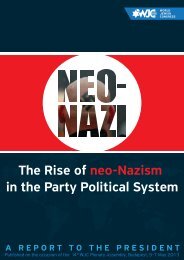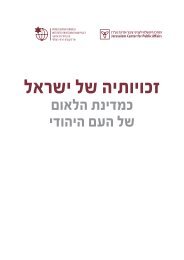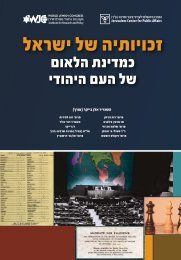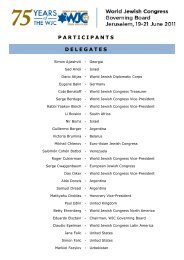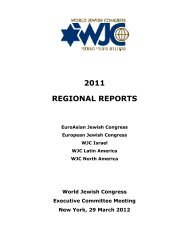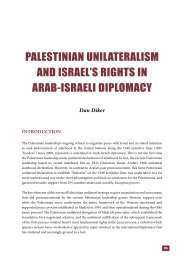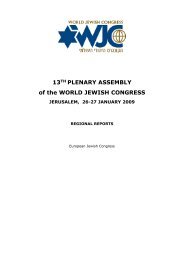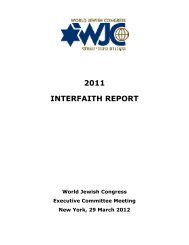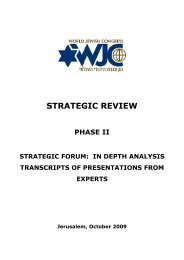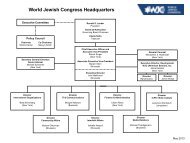Antisemitism Report 2009 - World Jewish Congress
Antisemitism Report 2009 - World Jewish Congress
Antisemitism Report 2009 - World Jewish Congress
You also want an ePaper? Increase the reach of your titles
YUMPU automatically turns print PDFs into web optimized ePapers that Google loves.
and Baha'is, also are large enough to have developed a network of institutions to serve their religious<br />
needs.<br />
"While there is no established religion, there also is not a strict church-state separation. However,<br />
there is a general principle that the state does not provide services to followers of one faith and then<br />
refuse to provide the same or similar services, if appropriate and practical, to adherents of other<br />
faiths. The impressive <strong>Jewish</strong> day school movement in Australia has benefited from a degree of<br />
government support, as have Muslim and Christian schools.<br />
"Jews have remained at roughly one-half percent of the Australian population since the early days of<br />
European settlement in the late eighteenth century. Jews were the only significant non-Christian<br />
minority for most of Australia's first two centuries after colonization. The <strong>Jewish</strong> community developed<br />
institutions to serve its needs, in a far more conducive environment than in most other countries. The<br />
success of <strong>Jewish</strong> Australians in maintaining a distinct identity while being unambiguously Australian<br />
is often used as evidence that multiculturalism can be achieved successfully."[2]<br />
Jones notes that "Muslims have also been in Australia for most of the modern period, but large-scale<br />
Muslim immigration only commenced in the last quarter of the twentieth century after the end of the<br />
White Australia Policy. Asian immigration has included Indonesian, Malaysian, and Indian<br />
subcontinental Muslims, Fijian Muslims, mass immigration from Lebanon and other Arab countries,<br />
and more recent immigration from African Muslim sources such as Somalia."[3]<br />
Common Interests<br />
Jones enumerates some areas of <strong>Jewish</strong>-Muslim cooperation, beginning in the 1970s when various<br />
Australian state and territory governments began to consider introducing antidiscrimination legislation.<br />
The consultation processes brought <strong>Jewish</strong> and Muslim community representatives together at<br />
government-hosted discussions and as part of interest-group coalitions from civil society. Among the<br />
common concerns were the provision of equal access to government services, recourse for victims of<br />
discrimination, and protection from harassment.[4]<br />
"Another area that brought Muslim and <strong>Jewish</strong> communities together was the labeling of food<br />
products, which assisted kosher, halal, and vegetarian consumers (as well as those with allergies).<br />
With the common advocacy in an area where there was little to divide the communities, some good<br />
personal relationships developed particularly between communal professionals.<br />
"Australia's multireligious reality has led to social and formal acceptance that Australians have<br />
different practices and requirements. This has provided opportunities for Jews and Muslims to jointly<br />
advocate for services, including subsidies for education at denominational schools and understanding<br />
for ritual requirements such as male circumcision, as well as opportunities to contribute to public<br />
debate as legitimate Australian religious voices.<br />
"In policy debates on Australia's immigration policy, in raising environmental awareness, and on a<br />
range of other issues, <strong>Jewish</strong> and Muslim leaders have been party to joint statements, generally with<br />
Christian leaders but in some cases with a broader range of religions represented.<br />
"In the Australian context, another area where <strong>Jewish</strong> and Muslim community organizations were able<br />
to work together effectively was Aboriginal Reconciliation. The federal government's Council for<br />
Aboriginal Reconciliation established a working group of faith communities who were seen as 'stake<br />
holders' because of their moral influence. The initial meeting of the working group only included<br />
Christians and one <strong>Jewish</strong> representative, but in subsequent meetings there was also Muslim, Baha'i,<br />
Buddhist, Hindu, and Sikh participation. The <strong>Jewish</strong> community representative who was elected to<br />
chair the group for most of its existence was nominated for the position by the representative of the<br />
Australian Federation of Islamic Communities (AFIC).<br />
136



